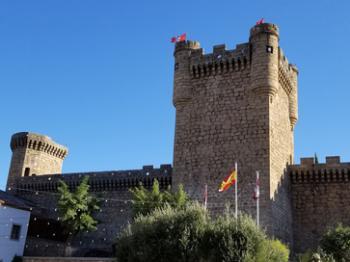Parador de Oropesa
This item appears on page 30 of the February 2019 issue.
My husband, Paul, and I rented a car in San Sebastián, Spain, and drove to Nerja on the country's southern coast in October 2018. During our several-day drive through Spain, we stayed at two paradores, one in Hondarribia and the other in Oropesa.
Hondarribia was a lovely place, where we had nice views of France from our room. We enjoyed exploring the Old Town there as well. Like the parador in Oropesa, the one in Hondarribia has a fascinating history, but I'm only going to write about the one in Oropesa, since it was the first historic parador to be included in the government-owned chain, in 1930.
The Parador de Oropesa (Plaza del Palacio, 1, 45560, Oropesa, Toledo, Spain; phone +34 925 4300 00, www.parador.es/en) is located between the Sierra de Gredos mountain range and the Tagus River, not far from Talavera de la Reina, just northwest of Toledo.
We stayed there two nights, paying about $235 a night, which came with a full buffet breakfast, including eggs, breads and pastries, cheeses and cold cuts, cold cereals, juices, coffee and tea.
This parador was formerly a castle and then was a palace for the counts of Oropesa. Our sleeping room was large and comfortable and still had the thick, stone, castle-like walls, but what was most impressive were the castle's keeps.
The parador is 82 feet tall, with five floors, all of which are open for visitors to explore. It is crowned by four sentry boxes and large battlements below. Views of the surrounding area and countryside from the keeps are spectacular.
The old castle — which is actually two castles, old and new — was built by the Arabs between the 12th and 13th centuries, and it has a rectangular layout. Only three of the four round towers remain.
The new castle was built around 1402 and became the residence of the Count of Oropesa. Its layout is also a rectangle, and it's where you can see the outstanding keeps.
The stairways in the keeps are considered to be among the most impressive of stairways in Spanish castles. We had fun climbing them, however they're steep, narrow and not well lit.
We really enjoyed our stay at the Parador de Oropesa. We didn't swim in the lovely outdoor swimming pool, as we spent so much time exploring the interior public rooms and the exterior of the castle, imagining what it was like to live there centuries ago.
If you're looking for a unique place to stay that is also of historical interest, we highly recommend one of Spain's many paradores. They're beautifully maintained and well run by the Spanish government and offer more history than you'd find in a modern hotel.
CONNIE MARTIN
Prescott, AZ

